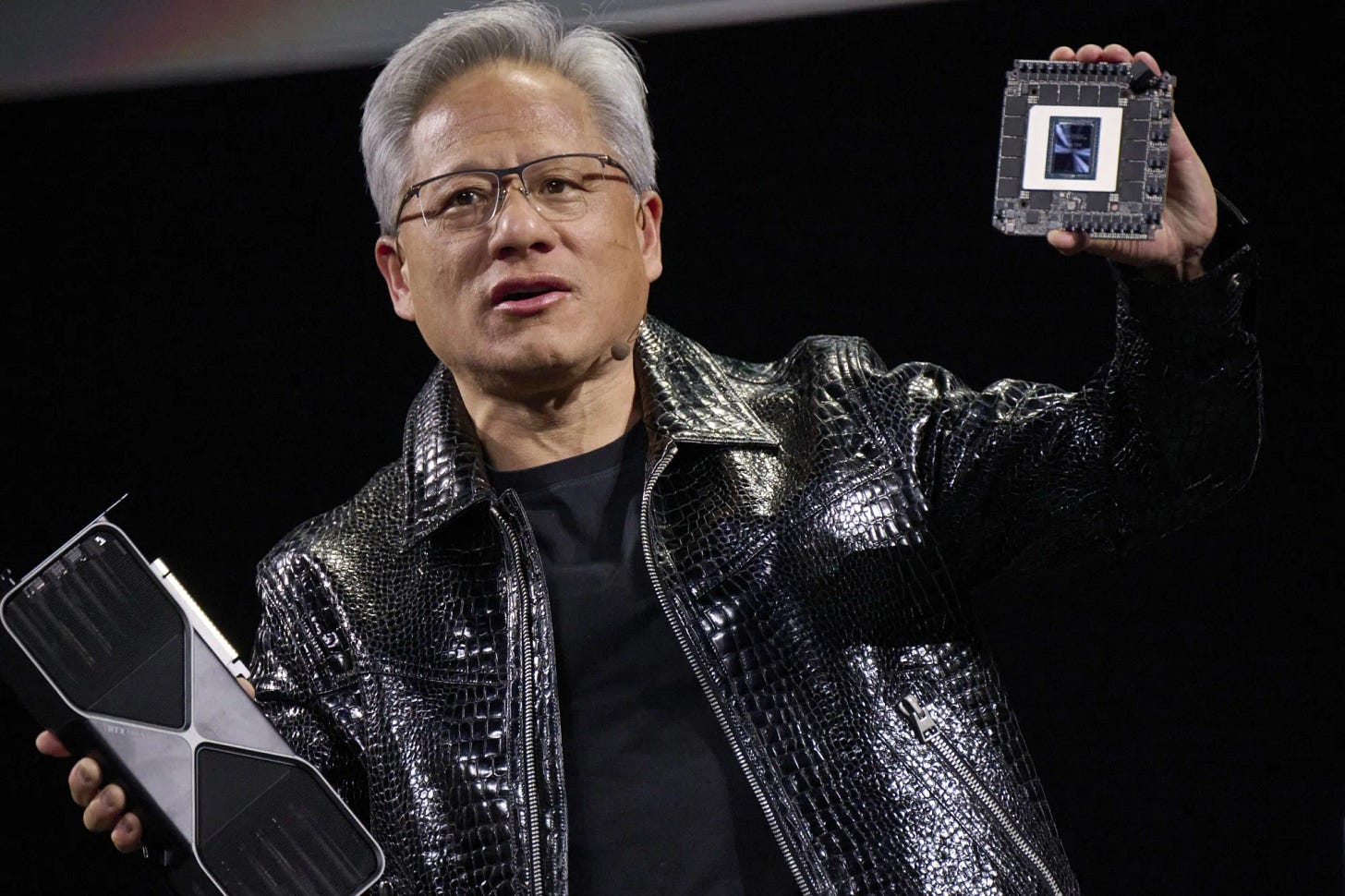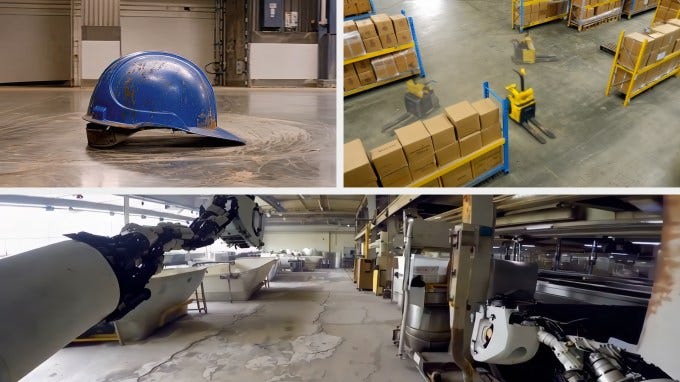AI: Nvidia lays out Physical AI roadmap at CES 2025. RTZ #594
...Blackwell AI GPUs and software moats across digital and physical AI realms
Investors concerned over Nvidia’s grip on its core AI hardware and software opportunity in this AI Tech Wave, should watch founder/CEO Jensen Huang’s keynote at CES 2025, which I’d discussed yesterday.
Decked out in a Las Vegas appropriate, shiny Alligator leather version of his signature jacket (see below), he laid out Nvidia’s roadmap as far as the eye could see. And it does stretch beyond its current leading position in LLM AI Scaling across multi-trillion dollar AI data centers over the coming decade.
Jensen made it clear that the Nvidia mission-driven road map around its core Blackwell GPUs and CUDA software libraries extends from what I’d call the ‘digital AI’ world of LLMs, to the ‘Physical AI’ world of self driving cars, robotics and beyond. Despite its best customers also planning to compete with it as well.
Bloomberg summarizes it in these two key points and then elaborates:
“Chipmaker’s CEO pitches tools for accelerating AI adoption”
“Nvidia updates its lineup in bid to spread AI to cars, robots”
“Huang took the stage at a packed arena in Las Vegas to kick off the CES trade show on Monday and present the new lineup, offering a vision for how AI will spread throughout the economy. The company wants its products to be the heart of a future tech world with a billion humanoid robots, 10 million automated factories, and 1.5 billion self-driving cars and trucks.”
“Interest in Nvidia’s products — and Huang’s forecasts — has exploded as companies rush to deploy new AI computing gear. The CEO outlined Nvidia’s products and strategy to his audience of hundreds for more than 90 minutes, including tie-ups with Toyota Motor Corp. and MediaTek Inc. that sent their shares more than 3% higher.”
“Before the retreat Tuesday, Nvidia’s stock had gained more than 200% in the last 12 months. Asian suppliers, including Taiwan Semiconductor Manufacturing Co. and Hon Hai Precision Industry Co., also surged on optimism about Nvidia’s prospects.”
Nvidia’s vision focused on Physical AI opportunities in autos, robots and beyond, accelerated by ‘Three Nvidia Computers’ for Robot Training/Auto training, simulation and Inference, as shown in the chart above.
Nvidia also didn’t disappoint the core CES audiences who’re interested in the next generation Blackwell powered Nvidia GPUs for gaming PCs and laptops, also about to be unleashed at CES 2025. It’s the new RTX 50 series of GPUs, with Blackwell AI GPUs on board for on-device synthetic frame generation:
“During Huang’s presentation Monday, he also delivered news to his traditional audience: gamers. Nvidia is launching an update to its GeForce GPUs — short for graphics processing units — which were created with the same Blackwell design that the company uses in its AI accelerators, Huang said.”
“New GeForce 50 series cards will take advantage of Blackwell’s capabilities to create even more realistic experiences for computer gamers, the company said. While traditional graphics chips build an image by calculating the shade of each pixel in the picture, the new technology will lean more heavily on AI to anticipate what the next frame should look like.”
“GeForce allowed AI to reach the masses, and now AI is coming home to GeForce,” Huang said during the presentation.”
“The flagship RTX 5090 model will be available later this month for $1,999, with less powerful cards following later. The RTX 5070, costing $549, will debut in February with better performance than the prior range’s top model, the RTX 4090, Nvidia said.”
It’ll take game developers some time to leverage these new Blackwell powered gaming GPUs, but it positions the company to bring Blackwell to its core roots in gaming laptops.
But AI data centers it where Nvidia’s bread is buttered these days, coming it at over $113 billion vs $11.8 billion in gaming revenues, as Bloomberg explains:
“As recently as 2022, gaming was Nvidia’s biggest source of sales. Now the chipmaker’s data center operation is far larger. It’s on course to contribute more than $100 billion this year, as the company’s accelerator chips are prized by the world’s largest tech companies. The next step is rolling out hardware and software to a larger swath of business and government agencies, helping diversify Nvidia’s revenue.”
Then there is the Physical AI part of the Nvidia roadmap:
“Extending AI into more of the physical world will transform industries worth $50 trillion, Nvidia said. But the move will also bring challenges. Robots and cars will require software that can handle real-life complexities in a safe way. The company has created Nvidia Cosmos to help make robots smarter and produce fully autonomous vehicles, Huang said.”
“Cosmos technology is able to create video from inputs such as text. That video then becomes the basis of virtual training, helping reduce dependence on expensive and time-consuming real-world experimentation. The generated video can be searched and honed so that important but infrequent events — such as a car’s encounter with an emergency vehicle — can be tested repeatedly.”
“Nvidia also is working with Uber Technologies Inc. to develop self-driving technology. The millions of trips that Uber handles daily will provide a trove of data for training AI models.”
And as I highlighted a few days ago, the company is also focused on local Blackwell powered chips for ‘Small AI’ applications at the Edge, for applications like automobiles, robotics and beyond. They announced a new product in the local computing arena as well:
“Nvidia is now also offering a desktop PC called Project Digits. The company is equipping the small $3,000 device with a single Grace Blackwell Superchip – a combination of central processor and graphics semiconductor – working with a large chunk of memory and fast connectivity. The idea is to provide developers with hardware capable of running very large AI models, ones that current laptops will struggle to handle.”
“The new machines, developed in partnership with Taiwan’s MediaTek, will run a version of the Linux operating system and aren’t designed for everyday use. Instead, they’re meant to help AI developers work locally when either connecting to the cloud or using conventional computers isn’t practical or possible.”
As Stratechery lays it out in “Nvidia at CES, Cosmos and Omniverse, Digits”:
“This keynote was very much an evolution of that theme. Yes, the surface level understanding of Nvidia’s transformation from a gaming company to an AI company is true, but maybe the most precise description is that Nvidia is a transformer company. To the point above, the 50-series is better than the 40-series at traditional graphics rendering, but the real standout feature — and the clear future of graphics — is leveraging transformers.”
That is to say, the production of ‘intelligence tokens’ at scale, and at ever improving power, processing and cost efficiencies. A moat across digital and physical AI realms.
For me the keynote underlined that Nvidia has a unique roadmap for where this AI Tech Wave is headed in its early days.
And Nvidia’s laser execution focus and discipline to make it happen at scale both horizontally and vertically across various industry domains. Stay tuned.
(NOTE: The discussions here are for information purposes only, and not meant as investment advice at any time. Thanks for joining us here)











